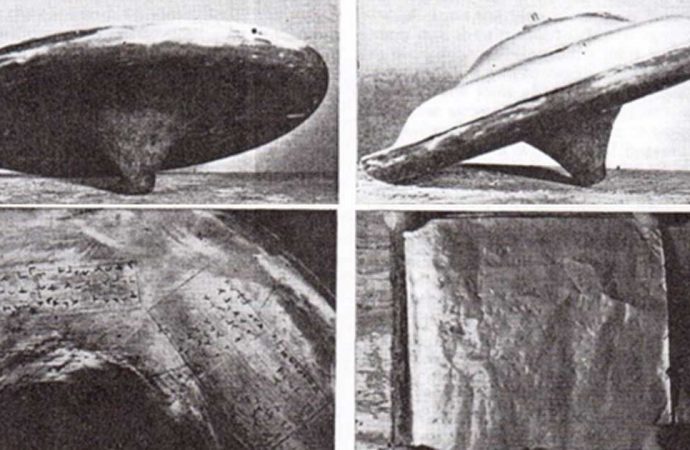Wreckage from a “miniature” UFO crash in North Yorkshire sixty years ago has been rediscovered in the archives of the Science Museum in London. Or has it?
Known as Britain’s “answer to America’s Roswell incident,” the Silpho Saucer story broke on December 9, 1957 in The Yorkshire Post when ‘a mystery’ disc was found on Yorkshire moor. Scarborough businessman Frank Dickenson and two friends were driving up Reasty Hill, near the village of Silpho, and their car stalled as ‘a glowing object in the sky’ landed in Borax Forest.
Mr. Dickenson found the metallic saucer in a patch of bracken, but when he returned with his friend the object was gone, so he placed a classified advert in the Scarborough newspaper and eventually bought it for £10. When the artifact was cut open a tiny book was found made of “17 thin copper sheets” covered in 2000 hieroglyphs.” Scarborough café owner, Philip Longbottom studied the disc and claimed it been sent to Earth by an alien called “Ullo” and the message warned: ‘You will improve or disappear’. Hieroglyphics were also found on the wreckage of the UFO that allegedly crashed at Roswell, New Mexico, in June 1947.
Measuring 45 cm (17.72 inches) in diameter and weighing 15 kg (33.07 lbs.), for half a century, UFO enthusiasts have speculated as to the destiny of this missing artifact. Now, parts of the “wreckage” have been rediscovered inside a tin cigarette box at the Science Museum Group ’s archive.

Pieces said to be from the wreckage of the Silpho UFO found in 1957. ( Dr. David Clarke/Sheffield Hallam University )
The remains of the ‘Silpho Moor Object’ were sent to London for examination in 1963 and included a “fused section of the metal and plastic from the outer casing, a length of hollow copper tubing and pieces from the copper booklet discovered inside.” Gordon Claringbull of the Natural History Museum, who specialized in meteorites and explosives said in a memo to the Science Museum that he was ‘prepared to wager anything’ that the pieces of metal were made on Earth, reported the Yorkshire Post.
A BBC report this week revealed how tests carried out at the time in Manchester University found the object’s shell “contained lead and the copper parts […] of unusual high purity.” This raised expectations in the UFO community, but a metallurgist soon concluded that because the disc had not been exposed to high temperatures it “could not have come from space.”

The Science Museum said it was likely the items in their collections were from Silpho Moor. ( David Clarke )
According to the Yorkshire Post , UFO expert Jenny Randles believes this metallic disc ‘is the most costly and well organized hoax that has ever taken place in Britain.”
Although the scientific community was skeptical, Air Chief Marshall Lord Dowding, who led the RAF during the Battle of Britain during WW2, examined the Silpho Saucer in 1958 and believed it was “genuine.” Describing it as a ‘a miniature pilot flying saucer’ – Lord Dowding was openly convinced it was “a genuine artefact from space,” according to the report in the Yorkshire Post.

The remaining parts of the Silpho UFO, found in 1957, were rumoured by the UFO community to have ended up on a scrap heap or even on display in a local fish and chip shop. ( Dr. David Clarke/Sheffield Hallam )
Since the discovery, skeptics have claimed the ‘saucer’ was made from a “domestic hot water cylinder in a back-street garage and planted on the moor as an elaborate hoax.” And this wouldn’t be the first time that a shiny part from a water cylinder has grabbed the world’s headlines – in 1974 another UFO part ‘allegedly’ crashed in Florida. Antoine and Jerri Betz, accompanied by their 21-year-old son Terry, discovered ‘’a bright metal globe, about the size of a bowling ball, just sitting there in the grass.”
When Terry played his guitar the ball “strangely resonated the music” and began to “move around, all on its own.” The media stir eventually caused scientists from NASA to inspect the Betz Sphere, and even some of them were convinced it had “otherworldly” origins. However, similarly to the Silpho Saucer story, the skeptics’ evidence was much stronger and came in the form of the “sphere’s owner.”

The Betz Sphere. ( paranormaljunkie.net)
A skeptiod.com article tells that after the story broke, artist James Durling-Jones in Taos, New Mexico came forward claiming that he had used similar spheres in several sculptures. He had made a trip in his Volkswagen bus collecting scrap “industrial ball valves” in two sizes: 10-inch (25.4 cm) balls weighing about 70 pounds (31.75 kg) and 8-inch (20.32 cm) balls weighing about 22 pounds (9.98 kg), exactly the same weight and dimensions as the Betz Sphere. Durling-Jones had strapped the metal balls on his luggage rack and drove through Jacksonville around Easter of 1971 when “a few of the balls rolled off the luggage rack and were lost,” until three years later when the Betzes came along.
It can be concluded that the Silpho Saucer and the Beta Sphere are unquestionably two of most famous INFOs (identified non-flying objects) in the world.
Top image: Images taken by Dr. John Dale in 1958 showing the intact saucer, the copper base with hieroglyphs and one of the copper sheets from the ‘booklet’ that contained a message from Ullo. Source of pictures: Dr. David Clarke/Sheffield Hallam University
Source of article: Ancient Origins

































Leave a Comment
You must be logged in to post a comment.